
We provide a comprehensive, family-friendly diagnostic audiology service for children >6 months of age. Assessments are completed by a fully qualified Pediatric Audiologist.
Early identification of hearing loss is important because children with hearing loss often fall behind their peers in speech and language development, cognitive skills and social skills.
Assessment of hearing in children begins with obtaining a detailed history to determine risk factors for hearing loss. Several methods can then be used to test hearing, depending on a child’s age, development, and health status.
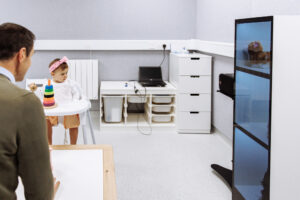
The child is seated between two visual reinforcing reward boxes with a loud speaker on top of each one. To condition the child a sound is played from one of the boxes on the left or right, as the child turns to the sound they are presented with a visual reward in the form of an illuminated puppet in the box.
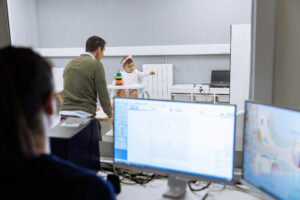
After several presentations the child has been conditioned to turn to one of the boxes when just a sound is played. A series of tones or warbles are then played at reducing intensity to obtain a minimal response level. After the child turns to a sound they are visually rewarded with one of the puppets.
In order to obtain ear specific hearing thresholds the child may wear headphones or have small insert phones placed in the ear canals to generate the stimulating sounds.
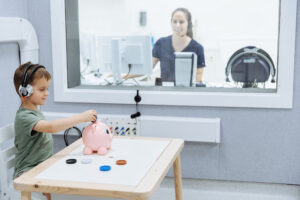 A game is played in which the child must perform an action when a sound is heard. This could take the form of putting toy people in a boat or building a tower from blocks. The complexity of the task can be modified to be age appropriate.
A game is played in which the child must perform an action when a sound is heard. This could take the form of putting toy people in a boat or building a tower from blocks. The complexity of the task can be modified to be age appropriate.
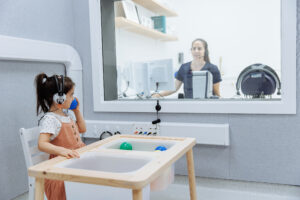 The child wears headphones or probes inserted into the ear canals (inserts) during the test. Sounds at various frequencies are presented to the child and gradually reduced in loudness. Each time they hear the sound they must perform the action until they can no longer hear the stimulus.
The child wears headphones or probes inserted into the ear canals (inserts) during the test. Sounds at various frequencies are presented to the child and gradually reduced in loudness. Each time they hear the sound they must perform the action until they can no longer hear the stimulus.
The point at which they stop performing the task is taken to be the hearing threshold at the particular frequency being tested. The process is repeated for a range of frequencies in each ear.
 Tones of varying frequency and intensity are played through headphones or insert phones. The child must press a hand held button for as long as they can hear a sound.
Tones of varying frequency and intensity are played through headphones or insert phones. The child must press a hand held button for as long as they can hear a sound.
The loudness of the sounds are reduced until the child stops responding, this is the threshold of hearing.
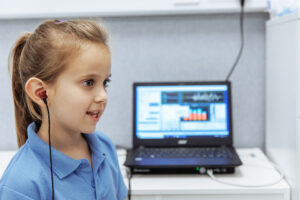
Sound is presented into the ear canal via a probe. The sound wave passes through the ear drum and middle ear then into the cochlear. This stimulates the hair cells in the cochlear causing the outer hair cells to twitch in response creating an echo. The echo passes back through the middle ear and ear drum where it is detected by a microphone situated in the probe. This signal is stored on a computer and plotted on a graph.
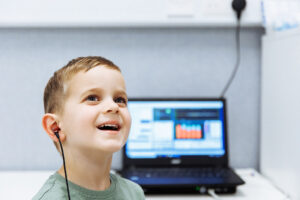
The results from this test give an indication of any damage that may be present in the sound detecting and amplifying hair cells. The outer hair cells are able to increase the sensitivity of the cochlear when functioning normally by up to a factor of 1000 times. An absence of, or damage to these cells, will significantly reduce hearing thresholds.
Computer analysis of the echo from these cells can indicate the level of function present in the cochlear under test.
 Tympanometry is not a hearing test but a procedure that can show how well the eardrum moves when a soft sound and air pressure are introduced in the ear canal. It’s helpful in identifying middle ear problems, such as fluid collecting behind the eardrum.
Tympanometry is not a hearing test but a procedure that can show how well the eardrum moves when a soft sound and air pressure are introduced in the ear canal. It’s helpful in identifying middle ear problems, such as fluid collecting behind the eardrum.
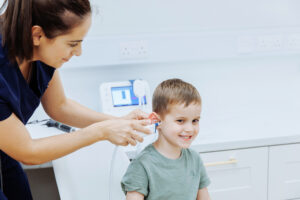
A tympanogram is a graphic representation of tympanometry. A “flat” line on a tympanogram may indicate that the eardrum is not mobile suggesting Otitis Media with Effusion (OME), while a “peaked” pattern often indicates normal function. A visual ear examination should be performed with tympanometry.
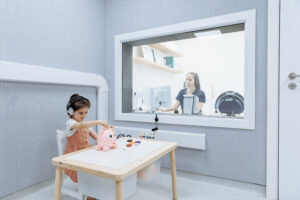
When a loud sound is presented to the ear, a protective mechanism is triggered that tightens the small bones (ossicles) that connect the ear drum to the cochlear and reduce the sensitivity of hearing.
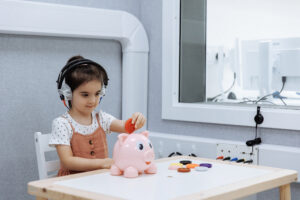
This procedure tests the pathway of the sound from the ear canal, through the middle ear, into the cochlear, up to the brainstem then back down to the muscle that tightens the ossicles.
You’ll get the results of the tests right after the assessment. We will discuss the results with you and agree what to do next. We will send a written report to you later.
At Wexford Audiology we provide a high quality, safe, effective and efficient services, meeting and responsive to the changing needs of those, from birth onwards, with potential or suspected difficulties with their hearing, auditory function, balance, or with tinnitus.
| Cookie | Duration | Description |
|---|---|---|
| cookielawinfo-checkbox-analytics | 11 months | This cookie is set by GDPR Cookie Consent plugin. The cookie is used to store the user consent for the cookies in the category "Analytics". |
| cookielawinfo-checkbox-functional | 11 months | The cookie is set by GDPR cookie consent to record the user consent for the cookies in the category "Functional". |
| cookielawinfo-checkbox-necessary | 11 months | This cookie is set by GDPR Cookie Consent plugin. The cookies is used to store the user consent for the cookies in the category "Necessary". |
| cookielawinfo-checkbox-others | 11 months | This cookie is set by GDPR Cookie Consent plugin. The cookie is used to store the user consent for the cookies in the category "Other. |
| cookielawinfo-checkbox-performance | 11 months | This cookie is set by GDPR Cookie Consent plugin. The cookie is used to store the user consent for the cookies in the category "Performance". |
| viewed_cookie_policy | 11 months | The cookie is set by the GDPR Cookie Consent plugin and is used to store whether or not user has consented to the use of cookies. It does not store any personal data. |
